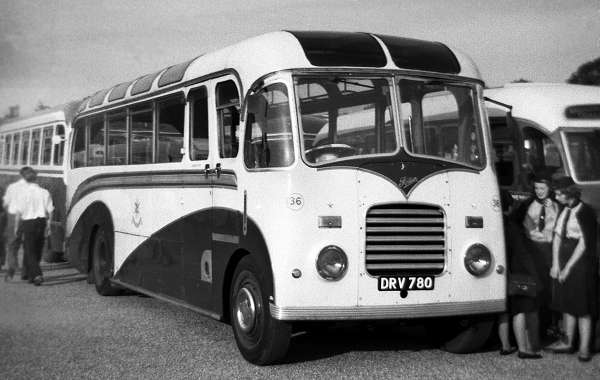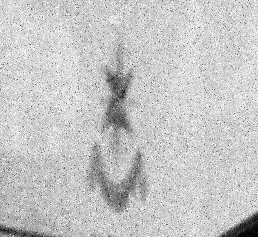Foden PVSC DRV 780
Foden PVSC DRV 780

This is one of my old Comet S photos. DRV 780 was a Foden PVSC6 with a Wadham C33F body delivered new in 1947 to Ewen of Petersfield, trading as Pioneer Coaches, see: www.flickr.com/photos/
This operator sold out to Southdown in October 1952, and the Foden was sold on elsewhere. It reappears again in 1960 or 1961 as shown with a later Plaxton body at some major parade – I was clearly a participant myself in this event, but I cannot now remember what it was. Perhaps someone might be able to fill the gaps in this Foden's history, and identify its operator in the picture above.
Roger Cox
05/04/14 - 07:17
What a truly fascinating vehicle! It certainly has some Plaxton features but it's unlike any other Plaxton body I've ever seen, particularly the almost straight waistrail, surely it must have been a one off? Presumably it was rebodied quite early, judging by the front grille, didn't most coaches so treated by Plaxtons carry the Venturer style from about 1952 onwards?
Chris Barker
05/04/14 - 09:15
Chris, you may well have a point. My view that this was a Plaxton body is based solely upon the frontal treatment which seems to have features from that coachbuilder. It might well be a product of one of the short lived firms of the mid 1950s.
Roger Cox
05/04/14 - 10:26
The frontal treatment looks remarkably like the Readings rebuilds on AEC Regal4's for Gosport and Fareham.
Pat Jennings
06/04/14 - 08:36
Pat Jennings' observation about the front of this coach resembling the Provincial's rebodied AEC buses is interesting. This is even more so when the Foden is compared with the two Reading bodied coaches produced for Provincial in 1955/56. These were built on ex-Oxford AEC Regent chassis, lengthened to 30' (but retained 7'6" width). These became 68/69 (OCG444 / PCG436). They were intended to resemble a standard Bedford/Duple coach of 1954, although the resemblance is only partial. I have a book on Reading coachbuilders (produced by the Provincial Society, title "First and Last"), but there is no product list, and no photo or mention of this specific vehicle. But the windscreen and front profile, including the curved side windows at the front are quite a close match. Unfortunately I don't have the means to add a photo for further comparison or comment. Pat's suggestion is worthy of further investigation, I think.
Michael Hampton
06/04/14 - 08:37
I'm sure you're correct, Pat, in your thoughts that this has a Reading & Co. body fitted. The timescale of the Provincial Regal 4's and this body match with the early 1960's. Here's a link for comparative purposes see this link:- www.flickr.com/photos/
Chris Hebbron
07/04/14 - 08:16
I follow the line of thinking that this might be a Reading body, but I still harbour a few doubts. The Provincial "Bedford clone" coaches constructed on Regent chassis do show several similarities with the Foden above, but they have a curved waistrail, whereas that of DRV 780 above is straight. I accept that small coachbuilders like Reading might well have tailored a design to suit a customer. On the other hand, the geography fits. We don't yet know where this Foden went after its disposal by Southdown, but Southsea, the base of the Reading business, is only a short distance from Petersfield, the original home of DRV 780. Interestingly, Reading was taken over by Sparshatts of Portsmouth in 1974, and Sparshatts in turn became part of Wadhams of Waterlooville, the firm that first bodied DRV 780 in 1947. A picture of one of the Provincial Regent/Duple lookalike coaches may be found on the Provincial Enthusiast Website: http://www.regent8.co.uk/ Click on the rotating arrow, and then go to 'The Oxford AEC connection'. The coach picture is about halfway down.
Roger Cox
07/04/14 - 15:19
Like many small bodybuilders, Roger, Reading & Co. did build bespoke one-off bodies with extensive variations. You name it, they did it: they really were a remarkable company. If you compare the Foden with the Regent 4 body, seen in the link in my post, it has a straight waistline, a virtually identical front, apart from the sidelights being higher on the bus than on the coach. The adjacent cab door/emergency door design and layout is identical. As for geography, Reading & Co. were not in Southsea, but in Hilsea, in North Portsmouth. Reading & Co. were next door to Sparshatts; their buildings were connected! The first takeover was very easy, therefore and was some 4 miles nearer Waterlooville for the second.!
Chris Hebbron
08/04/14 - 07:53
Body is definitely not Plaxton! Minor bodybuilders often used major builders' standard parts in the construction of bodies at this time. For example the front quarter glasses seen here are from the Plaxton Venturer/Consort range - too costly to produce from scratch, so were bought in. The body certainly looks like a Reading product, but identification of the operator is probably the only route to confirm this.
Philip Lamb
08/04/14 - 11:20

Is it possible to blow up the operator's name badge on the side panel to be able to make anything out?
Chris Hebbron
08/04/14 - 18:11
Chris, I entirely accept that small coachbuilding firms would tailor designs to suit customers' preferences, and Reading certainly did do just that. I am very familiar with the Regal 4 rebuilds of Gosport & Fareham, and, as a child resident at Alverstoke in the late '40s/early '50s, I knew them well in their earlier Harrington bodied rear entrance guise. They were regular performers on the Gosport - Stokes Bay route that ran round the back streets on the south side of Gosport, then past Gosport Park, and along to Alverstoke via Little Anglesey Road, where the waters of Stoke Lake literally lapped at the roadside. I made many return visits to Gosport in the years that followed, and had a very interesting chat with David Whitaker, the owner of preserved No.24, at a Duxford rally a few years ago. I do agree that all the evidence points to this being a Reading body on DRV 780. It is definitely not a Plaxton - perhaps Peter could amend the heading of this entry accordingly.

I have rescanned the "fleetname" at very high resolution (4800 dpi), Chris, but the meniscus lens of the Comet S simply wasn't capable of a suitable degree of detail. The result is attached, but it doesn't help very much. I seem to recall that this Foden picture was taken at a major parade at Guildford Cathedral, which I attended as an ATC cadet. This would tie in with the other geographical links to Hampshire and its environs.
Roger Cox
06/08/18 - 06:48
This answers the question of the operator and gives some further background to the rebodying:
http://busesonscreen.net/
DRV 780 was a near twin to HCG 215, having the Gurney Nutting body off MXB 556, but in its case rebuilt to full-front by Whitson rather than MTS.
Martin Ingle
08/08/18 - 06:24
Thanks for identifying the operator in this picture, Martin. It is certainly Barfoot &, Jones of Hanworth trading as Star Coaches. On the background story to the bodywork I remain a trifle unconvinced, as I have never seen a picture of a Gurney Nutting body with a completely straight waistrail as shown on DRV 780, and, indeed, on HCG 215, though I am ever open to education on this site. Also, I know of no Whitson bodies with the "Provincial" (i.e. Gosport & Fareham) style of front grille as seen on that operator's Reading bodies. Of MTS & Co I know and can find nothing, though a firm of vehicle repairers of that name currently exists in Watford; whether or not that has any relevance is uncertain.
Roger Cox
09/08/18 - 07:09
The Glenton Gurney Nutting bodies were re-fronted well before the majority [if not all] of the '˜Provincial' Reading bodies were built. The Sentinel SLC6s that Whitson bodied around the same time in 1954 had the same profile horizontal alloy slats as DRV 780.
The grille on DRV 780 bore merely a superficial resemblance to the '˜Provincial style'. It had a different outline shape to the various 'Provincial' versions (look carefully), had more and closer spaced bars and the alloy strip was thinner than the Reading version and weren't these all proprietary alloy strips anyway?
MTS were from Feltham: http://archive.commercialmotor.com/One
Glenton had their own ideas on coach design and their post-war style was quite different from contemporary designs. They went for 'higher class' coachbuilding firms happy to accommodate them but the first choice, Vincent, lacked durability: http://archive.commercialmotor.com/Two
So they went to Gurney Nutting with their bespoke design. I expect they were pleased to build them.
Dennis records show that the chassis for MXB 557 [912J3] was delivered to Gurney Nutting. Such a note is rare and they have no such comment on the other two.
Martin Ingle
Comments regarding the above are more than welcome please get in touch via the 'Contact Page' or by email at
All rights to the design and layout of this website are reserved Old Bus Photos does not set or use Cookies but Google Analytics will set four see this
Old Bus Photos from Saturday 25th April 2009 to Friday 26th April 2024